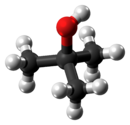Tert-Butanol
|
|
|||
 |
|||
| Names | |||
|---|---|---|---|
|
Preferred IUPAC name
2-Methylpropan-2-ol
|
|||
| Other names
tert-Butyl alcohol
tert-Butanol (incorrect) Trimethyl carbinol, 2-Methyl-2-propanol 2M2P |
|||
| Identifiers | |||
|
75-65-0 |
|||
| 3D model (Jmol) | Interactive image | ||
| 906698 | |||
| ChEBI |
CHEBI:45895 |
||
| ChEMBL |
ChEMBL16502 |
||
| ChemSpider |
6146 |
||
| DrugBank |
DB03900 |
||
| ECHA InfoCard | 100.000.809 | ||
| EC Number | 200-889-7 | ||
| 1833 | |||
| MeSH | tert-Butyl+Alcohol | ||
| PubChem | 6386 | ||
| RTECS number | EO1925000 | ||
| UNII |
MD83SFE959 |
||
| UN number | 1120 | ||
|
|||
|
|||
| Properties | |||
| C4H10O | |||
| Molar mass | 74.12 g·mol−1 | ||
| Appearance | Colorless liquid | ||
| Odor | Camphorous | ||
| Density | 0.775 g/mL | ||
| Melting point | 25 to 26 °C; 77 to 79 °F; 298 to 299 K | ||
| Boiling point | 82 to 83 °C; 179 to 181 °F; 355 to 356 K | ||
| miscible | |||
| log P | 0.584 | ||
| Vapor pressure | 4.1 kPa (at 20 °C) | ||
| Acidity (pKa) | 16.54 | ||
| -57.42·10−6 cm3/mol | |||
|
Refractive index (nD)
|
1.387 | ||
| Thermochemistry | |||
| 215.37 J K−1 mol−1 | |||
|
Std molar
entropy (S |
189.5 J K−1 mol−1 | ||
|
Std enthalpy of
formation (ΔfH |
−360.04–−358.36 kJ mol−1 | ||
|
Std enthalpy of
combustion (ΔcH |
−2.64479–−2.64321 MJ mol−1 | ||
| Hazards | |||
| Safety data sheet | inchem.org | ||
| GHS pictograms |
 
|
||
| GHS signal word | DANGER | ||
| H225, H319, H332, H335 | |||
| P210, P261, P305+351+338 | |||
|
EU classification (DSD)
|
|
||
| R-phrases | R11, R20, R36/37 | ||
| S-phrases | (S2), S9, S16, S46 | ||
| NFPA 704 | |||
| Flash point | 11 °C (52 °F; 284 K) | ||
| 480 °C (896 °F; 753 K) | |||
| Explosive limits | 2.4–8.0% | ||
| Lethal dose or concentration (LD, LC): | |||
|
LD50 (median dose)
|
3559 mg/kg (rabbit, oral) 3500 mg/kg (rat, oral) |
||
| US health exposure limits (NIOSH): | |||
|
PEL (Permissible)
|
TWA 100 ppm (300 mg/m3) | ||
|
REL (Recommended)
|
TWA 100 ppm (300 mg/m3) ST 150 ppm (450 mg/m3) | ||
|
IDLH (Immediate danger)
|
1600 ppm | ||
| Related compounds | |||
|
Related butanols
|
2-Butanol |
||
|
Related compounds
|
2-Methyl-2-butanol Trimethylsilanol |
||
|
Except where otherwise noted, data are given for materials in their standard state (at 25 °C [77 °F], 100 kPa).
|
|||
|
|
|||
| Infobox references | |||
tert-Butyl alcohol (TBA), also called tert-butanol, is the simplest tertiary alcohol, with a formula of (CH3)3COH (sometimes represented as t-BuOH). It is one of the four isomers of butanol. tert-Butyl alcohol is a colorless solid, which melts near room temperature and has a camphor-like odor. It is miscible with water, ethanol and diethyl ether.
t-Butyl alcohol has been identified in beer and chickpeas. It is also found in cassava which is used as fermentation ingredient in certain alcoholic beverages.
tert-Butyl alcohol is derived commercially from isobutane as a co-product of propylene oxide production. It can also be produced by the catalytic hydration of isobutylene, or by a Grignard reaction between acetone and methylmagnesium chloride.
Purification can not be performed by simple distillation due to formation of an azeotrope with water, although initial drying of the solvent containing large amounts of water is performed by adding benzene to form a tertiary azeotrope and distilling off the water. Smaller amounts of water are removed by drying with CaO, K2CO3, CaSO4, or MgSO4, followed by fractional distillation. Anhydrous t-butanol is obtained by further refluxing and distilling from magnesium activated with iodine, or alkali metals such as sodium or potassium. Other methods include the use of 4A MO sieves, aluminum tert-butylate, CaH2, or fractional crystallization under inert atmosphere.
...
Wikipedia



